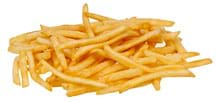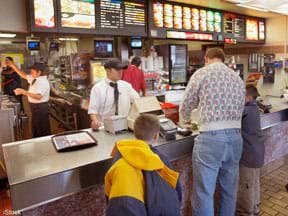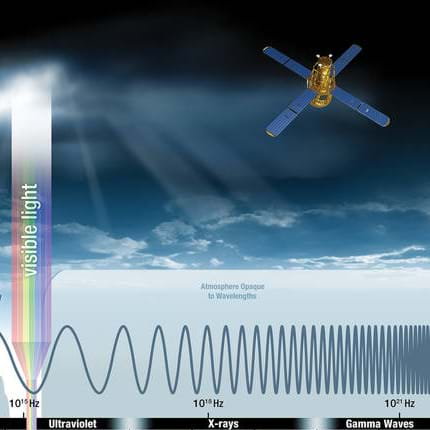Quick Look
Grade Level: 11 (8-11)
Time Required: 1 hours 30 minutes
(can be split into two 45-minute sessions)
Expendable Cost/Group: US $0.00 This activity uses writing and drawing materials found in most classrooms.
Group Size: 4
Activity Dependency: None
Subject Areas: Number and Operations, Science and Technology
NGSS Performance Expectations:

| HS-ETS1-3 |

Summary
Students are introduced to the idea of improving efficiency by examining a setting that is familiar to many teenagers—fast food restaurants. More specifically, they learn about the concepts of trade-offs, constraints, increasing efficiency and systems thinking. They consider how to improve the efficiency of a restaurant that is struggling, through delegating tasks, restructuring employee responsibilities and revising a floor plan, all while working within limitations and requirements. Finally, students summarize and defend their suggested changes in argumentative essays.Engineering Connection
Students from backgrounds typically underrepresented in the engineering field often feel that they lack engineering experiences and familiarity. This activity was designed to help students make connections between their everyday experiences and engineering. Engineers seek to represent diverse communities, businesses and needs. Like engineers, students are tasked with identifying strengths and weaknesses in an existing system. Students are introduced to the concepts of drafting and trade-offs when they revise a floor plan. Then, as in real-world engineering, students are challenged to explain and defend their improved designs in argumentative essays.
Learning Objectives
After this activity, students should be able to:
- Critically analyze the efficiency of systems in everyday situations.
- Evaluate and redesign the functionality of a floor plan.
- Make decisions after considering trade-offs.
- Defend design decisions through argumentative writing.
Educational Standards
Each TeachEngineering lesson or activity is correlated to one or more K-12 science,
technology, engineering or math (STEM) educational standards.
All 100,000+ K-12 STEM standards covered in TeachEngineering are collected, maintained and packaged by the Achievement Standards Network (ASN),
a project of D2L (www.achievementstandards.org).
In the ASN, standards are hierarchically structured: first by source; e.g., by state; within source by type; e.g., science or mathematics;
within type by subtype, then by grade, etc.
Each TeachEngineering lesson or activity is correlated to one or more K-12 science, technology, engineering or math (STEM) educational standards.
All 100,000+ K-12 STEM standards covered in TeachEngineering are collected, maintained and packaged by the Achievement Standards Network (ASN), a project of D2L (www.achievementstandards.org).
In the ASN, standards are hierarchically structured: first by source; e.g., by state; within source by type; e.g., science or mathematics; within type by subtype, then by grade, etc.
NGSS: Next Generation Science Standards - Science
| NGSS Performance Expectation | ||
|---|---|---|
|
HS-ETS1-3. Evaluate a solution to a complex real-world problem based on prioritized criteria and trade-offs that account for a range of constraints, including cost, safety, reliability, and aesthetics, as well as possible social, cultural, and environmental impacts. (Grades 9 - 12) Do you agree with this alignment? |
||
| Click to view other curriculum aligned to this Performance Expectation | ||
| This activity focuses on the following Three Dimensional Learning aspects of NGSS: | ||
| Science & Engineering Practices | Disciplinary Core Ideas | Crosscutting Concepts |
| Evaluate a solution to a complex real-world problem, based on scientific knowledge, student-generated sources of evidence, prioritized criteria, and tradeoff considerations. Alignment agreement: | When evaluating solutions it is important to take into account a range of constraints including cost, safety, reliability and aesthetics and to consider social, cultural and environmental impacts. Alignment agreement: | New technologies can have deep impacts on society and the environment, including some that were not anticipated. Analysis of costs and benefits is a critical aspect of decisions about technology. Alignment agreement: |
International Technology and Engineering Educators Association - Technology
-
There is no perfect design.
(Grades
6 -
8)
More Details
Do you agree with this alignment?
-
Create solutions to problems by identifying and applying human factors in design.
(Grades
6 -
8)
More Details
Do you agree with this alignment?
-
Document trade-offs in the technology and engineering design process to produce the optimal design.
(Grades
9 -
12)
More Details
Do you agree with this alignment?
State Standards
Utah - Science
-
Use proper English in oral and written reports.
(Grades
9 -
12)
More Details
Do you agree with this alignment?
Materials List
Each group needs:
- writing materials: paper, pencil or word processor
- drawing materials: blank paper, pencil, ruler
- Marla's Restaurant Supplemental Intro Activity, one per group
- Pete's Burger Palace Activity Packet, one per group
- Blank Schedule, one per group
Worksheets and Attachments
Visit [www.teachengineering.org/activities/view/usu_fastfood_activity1] to print or download.Introduction/Motivation
When getting dressed in the morning, have you ever put on your shoes BEFORE your pants? Probably not! Do you brush your teeth BEFORE eating breakfast? Maybe!? Every day, all of us make choices about how to perform our daily routines—some of them are more efficient than others. What do we mean by "efficiency"? (Listen to student ideas.) Maximum "efficiency" means accomplishing a task by using the least amount of time, energy, materials and/or costs possible.
One important aspect of what engineers do every day is to analyze and improve efficiency. By making changes to technology and human processes, engineers are always trying to think of new ways to save us time, energy, materials and costs. As an example, think of smart phones. Today, it is possible for people to compile all of their music on a single device, saving them the trouble and space of collecting CDs and tape cassettes.
Engineers also look for ways to save people time in their daily lives by making "trade-offs." A trade-off occurs when we sacrifice one thing to gain something else that we value more. Consider this: Juan loves to watch a movie every Friday night and excitedly awaits new releases. However, going to see a new movie every week can get expensive; a single ticket can cost $10! Instead, Juan goes to a local second-run theater that shows older movies for a much lower price of $2 per ticket. Juan sacrifices the excitement of seeing a brand new movie as soon as it is released, but he gains $8 in savings by seeing the movie after it has been out for a few weeks at the second-run theater. For Juan, his desire to save money outweighs his desire to see new movies right away and thus he has made an effective trade-off.
In the following engineering activity, you will learn about Pete's Burger Palace, a restaurant that is struggling to make a profit because its daily routines are inefficient. As an aspiring young engineer, you will learn all about Pete's and then challenged to modify their procedures to make them more efficient. As you make decisions for Pete, keep in mind this concept of trade-offs.
Procedure
Teacher Background
The "Pete's Burger Palace" engineering activity is intended to get students thinking about efficiency. In the hypothetical scenario, Pete's is a financially struggling, "mom and pop" fast food restaurant that is competing with a more streamlined competitor. Pete could do a number of things better and this activity is intended to be an open-ended and creative design challenge; there is no one correct or perfect answer. As students work in teams as systems engineers, prompt students to apply their own personal experiences and real-world background knowledge of restaurants to develop realistic solutions for Pete to implement.
Over the course of this mini-unit, students are asked to delegate employee responsibilities and labor hours, assess best practices in business, draft a floor plan and write an argumentative essay. Depending on your school's schedule, this activity could be expanded from 90 minutes to a few days or an entire week.
Summary of tasks:
Task 1 – To redistribute employee responsibilities
Task 2 – To redesign the daily schedule (while adhering to a few parameters, aka constraints)
Task 3 – To summarize the labor hours they have allotted
Task 4 – To redesign the restaurant floor plan
Task 5 – To defend their final recommendations and changes via argumentative writing
Encourage students to share the responsibility for each task within their groups, but try to prevent students from splitting up the entire unit (by assigning entire tasks to individual students) by only assigning them one task at a time. Then, make Task 5 an individual assignment to give all students the chance to practice and demonstrate their overall activity comprehension and writing competence. Refer to the teacher guide for an in-depth explanation of each task as well as suggested rubrics for scoring student work.
Before the Activity
- Review the attached three student handouts and the Pete's Burger Palace Teacher Guide, which explains each task in depth and suggests rubrics for scoring student work.
- After reviewing the handouts, think of a few familiar establishments or institutions in your community that students are familiar with. Prepare for a discussion with students by thinking of some real-world examples of efficiency and inefficiency that they are familiar with, perhaps even the school's cafeteria or the school bus loading/unloading process.
- Decide if you would like to include the Marla's Restaurant Supplemental Intro Activity as a pre-activity assessment and practice exercise to help students better understand the concept of trade-offs.
- Decide if you want students to work in small groups of four or in pairs.
- Make copies of the Pete's Burger Palace Activity Packet, the Blank Schedule, and if desired, the Marla's Restaurant Supplemental Intro Activity, one each per group.
- Review the different parts of the Pete's Burger Palace Activity Packet and decide how you think each would best be completed in your classroom. You might decide to give students collaboration time between completing each step to compare their solutions with each other, or to present to the group.
With the Students
- Divide the class into groups of four students each. Alternatively, the activity is also well suited to partners.
- (optional) Lead students through Marla's Restaurant Supplemental Intro Activity. If not doing the activity, spend some time discussing the vocabulary words, especially the concept of trade-offs. Further, make the concept more personal by introducing and discussing some real-world examples of efficiency and inefficiency with a few familiar establishments and institutions in your community.
- Hand out Pete's Burger Palace Activity Packet. Guide students through the background information (pages 1-6) either by reading it aloud or having students read it in their groups. When each background section is completed, ask students questions to check comprehension. Consider short discussions at the end of each section to identify main ideas. Example discussion questions and answers:
- Why does Pete need help reorganizing his business? (Answer: A more efficient competitor has opened and Pete is losing customers. He needs to make his restaurant more efficient in order to win back their business.)
- What are the different menu items Pete's employees need to prepare and serve? (Answer: Hamburgers, chicken burgers, chicken nuggets, French fries, fountain drinks.)
- What are the three main positions at Pete's? (Answer: Cashier, grill, assembly.)
- What are their primary responsibilities? (Answer: Cashiers take orders and money. Grillers prepare hot food. Assemblers prep cold food, build sandwiches and put together orders.)
- When are the busiest and slowest times at Pete's? (Answer: Pete's is slow in the mornings, but is very busy from noon–2PM and again from 5–7PM.)
- What are some of the suggestions the workers have for improving the restaurant? (The many possible answers include: stronger support from management, delegating responsibilities differently, higher employee retention, higher health and safety standards, schedule changes and introducing pre-prepared ingredients.)
- What are some of Pete's main concerns? (The many possible answers include maintaining quality standards, not over-paying for labor, and making the most of the existing equipment and space.)
- What do engineers mean when they talk about "constraints"? (Answer: For engineers, constraints are the requirements and limitations that must be considered when designing a workable solution to a problem. Constraints might be in the form of costs, timing, speed, quality, safety, reliability, material availability, aesthetics and even social, cultural and environmental impacts. To find workable solutions sometimes requires balancing competing constraints and making trade-offs.)
- What are Pete's constraints? (Answer: Quality product, employee health, labor costs, equipment availability and kitchen size.)
- Direct students to complete Tasks 1-3 in their small groups, working collaboratively and completing each task before moving on to the next one. In Task 1: Employee Responsibilities, students revise Pete's labor delegation by reassigning each station's tasks. In Task 2: An Average Day at Pete's, students use the Blank Schedule to create a new schedule for Pete to follow, keeping their new labor delegations in mind. In Task 3: Labor Hours, students tally up the labor hours they used to make sure they have not scheduled more than the 30-hour limit. Permit them to make changes to earlier tasks if ideas or improvements are discovered during later tasks. As students work on Tasks 1-4, make time, as needed, for them to collaborate and share, pointing out that there is no ONE correct or perfect answer.
- Direct students to complete Task 4 in their small groups. In Task 4: Floor Plan, students review and examine the existing floor plan and sketch a new, revised plan of their own that is more efficient.
- Have students complete Task 5 individually. In Task 5: Final Recommendations, students each compose an essay in which they explain and defend their suggested changes to Pete's existing business model. Direct students to complete this task in the form of a five-paragraph argumentative essay. This concluding task gives each student the opportunity to express his/her full understanding of the preceding tasks and activity concepts in a well-constructed persuasive summary document.
Vocabulary/Definitions
constraint: A limitation or restriction. For engineers, constraints are the requirements and limitations that must be considered when designing a workable solution to a problem.
drafting: Composing plans to visually communicate how a structure is laid out.
efficiency: Completing a task with the lowest use of time, energy, materials and/or costs.
systems thinking: Considering the ways in which interdependent components of a system affect one another.
trade-off: Sacrificing one asset to gain another that is considered equally valuable or useful.
Assessment
Pre-Activity Assessment
Marla's Restaurant: Hand out to students the Marla's Restaurant Supplemental Intro Activity. Marla is considering opening a new restaurant in your community and needs to decide what kind of restaurant format to open. Direct students to work in pairs to decide on appropriate trade-offs for Marla to make. Advise students to keep the following questions in mind. These questions have no right or wrong answers, thus, expect students' assessments to vary according to their own perceptions of their community.
- To whom would each restaurant option appeal?
- To whom would each restaurant option not appeal?
- In your community, which options would be most lucrative? Most controversial?
- With each option, what will Marla gain or lose?
Class Discussion: Ask students to share their answers to a few of the scenarios in the Marla activity and discuss how their answers are similar and how they differ. Emphasize that it is important for engineers and restaurant owners alike to assess the potential trade-offs they make with each component of their designs.
Activity Embedded Assessment
Improving Pete's Burger Palace: As students complete the five main tasks of this open-ended design challenge—to redistribute employee responsibilities, redesign the daily schedule, tally the total labor hours, redesign the restaurant floor plan and write a persuasive recommendation of changes to make—refer to the Pete's Burger Palace Teacher Guide for detailed explanations of the purpose of each task as well as a suggested scoring rubric for each task. Tasks 1-4 are collaborative group efforts while Task 5 is an individual assignment. Use the rubrics to evaluate student engagement and depth of comprehension.
Post-Activity Assessment
Argumentative Writing: The best indicator of what students learned is found in the logic and evidence they present in their individual, argumentative essays. Use the suggested rubric in Pete's Burger Palace Teacher Guide to score them.
Activity Extensions
For extra credit, assign students to evaluate the efficiency of some enterprise, service, business, project or process in their own community, such as restaurants, hospitals, traffic, utilities, events, construction projects, etc. Ask them to craft essays in which they summarize their investigations and observations by reporting on efficiencies and inefficiencies found in the use of time, energy, materials and costs. As makes sense, have them focus on employee responsibilities, schedules, labor hours, and floor plans, and make suggestions for improved efficiencies, given certain objectives.
Subscribe
Get the inside scoop on all things TeachEngineering such as new site features, curriculum updates, video releases, and more by signing up for our newsletter!More Curriculum Like This

Through role playing and problem solving, this lesson sets the stage for a friendly competition between groups to design and build a shielding device to protect humans traveling in space. The instructor asks students—how might we design radiation shielding for space travel?
Copyright
© 2015 by Regents of the University of Colorado; original © 2014 Utah State UniversityContributors
Christina Sias; Amy A. Wilson; Alex MejiaSupporting Program
NSF DRK-12 Project, College of Engineering, Utah State UniversityAcknowledgements
This material was developed based upon work supported by the National Science Foundation under grant no. DRL 1222566—the Community-Based Engineering Design Challenges for Adolescent English Learners DRK-12 project in the Mechanical and Aerospace Engineering Department, College of Engineering, Utah State University. Any opinions, findings, and conclusions or recommendations expressed in this material are those of the authors and do not necessarily reflect the views of the National Science Foundation.
Last modified: October 26, 2021







User Comments & Tips